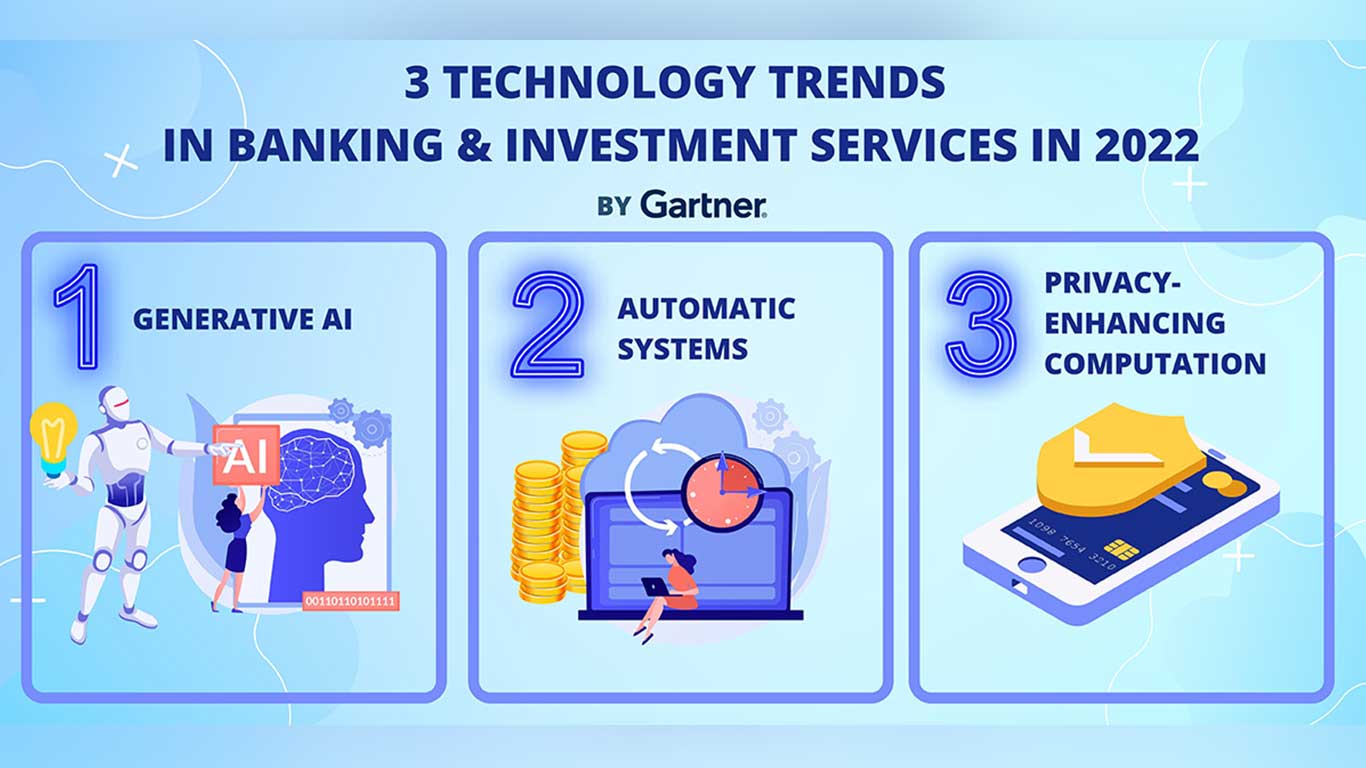Gartner Identifies Three Technology Trends Gaining Traction in Banking and Investment Services in 2022
Banks and Investment Firms Will Spend $623 Billion on Technology Products and Services in 2022
- Banks will apply generative AI in growth areas such as fraud detection, trading prediction and risk factor modeling.
- Autonomic systems exist in a basic form as roboadvisors, but more advanced forms will emerge.
- 60% of large organizations will use one or more privacy-enhancing computation techniques by 2025.
Generative artificial intelligence (AI), autonomic systems and privacy-enhancing computation are three technology trends gaining traction in banking and investment services in 2022, according to Gartner, Inc. These trends will continue to grow over the next two to three years, contributing to growth and transformation of financial services organizations.
“While growth is the top priority, the need to manage risk, optimize costs and increase efficiency also requires new technology innovations,” said Moutusi Sau, VP Analyst at Gartner. “Generative AI enables bank CIOs to offer technology solutions to the business in pursuit of revenue growth, while autonomic systems and privacy-enhancing computation are long-term solutions that provide new options for business transformation in financial services.”
IT spending by banking and investment services firms is forecast to grow 6.1% in 2022 to $623 billion worldwide. The largest category of spending is IT services, which includes consulting and managed services and accounts for 42% of total IT spending in the sector at $264 billion. The fastest growing category is software, with spending forecast to increase by 11.5% to $149 billion.
IT spending by banking and investment services firms in Thailand is forecast to grow 6.5% in 2022 to THB 82.2 billion. The largest category of spending is IT services, which includes consulting and managed services at THB 22.4 billion. The fastest growing category is software, with spending forecast to increase by 14% to 13.5 billion Baht.
The three emerging technologies identified by Gartner collectively contribute to goals to run, grow and transform a business and have demonstrated use cases in the banking and investment industry.
Trend 1: Generative AI
Gartner predicts that 20% of all test data for consumer-facing use cases will be synthetically generated by 2025. Generative AI learns a digital representation of artifacts from data and generates innovative new creations that are similar to the original but does not repeat it.
In banking and investment services, application of generative adversarial networks (GANs) and natural language generation (NLG) can be found in most scenarios for fraud detection, trading prediction, synthetic data generation and risk factor modeling. It has potential because of the ability to take personalization to new heights.
Trend 2: Autonomic Systems
Autonomic systems are self-managed physical or software systems that learn from their environments and dynamically modify their own algorithms in real-time to optimize their behavior in complex ecosystems. They create an agile set of technology capabilities that support new requirements and situations, optimize performance and defend against attacks without human intervention.
Currently, autonomic systems are mostly software-based in the banking context. However, humanoid robots are emerging in smart branches that are examples of hardware-based autonomous systems that cater to clients and customers. They could be applied in autonomous debt management, personal finance assistants and automated lending. Roboadvisors are essentially low-level autonomic systems, although there are still trust concerns due to their high level of automation.
Gartner predicts that by 2024, 20% of organizations that sell autonomic systems or devices will require customers to waive indemnity provisions related to their products’ learned behavior.
Trend 3: Privacy-Enhancing Computation
Privacy-enhancing computation (PEC) secures the processing of personal data in untrusted environments — which is increasingly critical due to evolving privacy and data protection laws, as well as growing consumer concerns. It uses a variety of privacy-protection techniques to allow value to be extracted from data while still meeting compliance requirements.
Gartner predicts that 60% of large organizations will use one or more privacy-enhancing computation techniques in analytics, business intelligence or cloud computing by 2025.
Within financial services, data has an inherent role in any analytics, computing and data monetization efforts. The adoption of PEC is on the rise in use cases like fraud analysis, intelligence operations, data sharing and anti-money-laundering.
ธนาคารและบริษัทลงทุนจะใช้เงินกับผลิตภัณฑ์และบริการด้านเทคโนโลยีถึง 623 พันล้านดอลลาร์สหรัฐฯ ในปี 2565
- ธนาคารจะนำเทคโนโลยี Generative AI มาใช้ในขอบเขตของส่วนงานต่าง ๆ ที่มีการเติบโต อาทิ การตรวจจับการฉ้อโกง การคาดการณ์การซื้อ-ขาย และการจำลองปัจจัยเสี่ยง
- ระบบอัตโนมัติ (Autonomic Systems) จะกลายเป็นเทคโนโลยีพื้นฐานรูปแบบเดียวกับ Roboadvisors แต่จะมีพัฒนาการในขั้นสูงกว่า
- 60% ขององค์กรขนาดใหญ่จะใช้เทคนิค “การประมวลผลเพื่อเพิ่มประสิทธิภาพความเป็นส่วนตัว (Privacy-Enhancing Computation)” อย่างน้อยหนึ่งเทคนิคภายในปี 2568
การ์ทเนอร์ เผยสามแนวโน้มเทคโนโลยีที่ได้รับแรงหนุนสำคัญจากบริการธนาคารและการลงทุนในปี 2565 ประกอบด้วย เทคโนโลยี Generative Artificial Intelligence (AI), Automatic Systems และ Privacy-Enhancing Computation ซึ่งเทคโนโลยีทั้งสามกลุ่มนี้จะยังเติบโตต่อเนื่องในสองหรือสามปีจากนี้ โดยมีส่วนสนับสนุนการเติบโตและการเปลี่ยนแปลงขององค์กรธุรกิจที่ให้บริการทางการเงิน
มูตูซี เซา รองประธานฝ่ายวิจัยของการ์ทเนอร์ กล่าวว่า “ขณะที่การเติบโตมีความสำคัญสูงสุดต่อธุรกิจ ความจำเป็นในการจัดการความเสี่ยง การเพิ่มประสิทธิภาพด้านต้นทุนและการดำเนินงานต่างต้องการนวัตกรรมและเทคโนโลยีใหม่ ๆ Generative AI ช่วยให้ผู้บริหารไอทีของธนาคารสามารถนำเสนอเทคโนโลยีโซลูชั่นให้กับธุรกิจเพื่อสร้างรายได้ให้เติบโตได้ ขณะที่ Autonomic Systems และ Privacy-Enhancing Computation จะเป็นโซลูชั่นดำเนินการระยะยาวที่นำเสนอทางเลือกใหม่ ๆ สำหรับการเปลี่ยนแปลงทางธุรกิจในด้านบริการทางการเงิน”
การ์ทเนอร์คาดว่ามูลค่าการใช้จ่ายด้านไอทีของธุรกิจธนาคารและการลงทุนทั่วโลกในปี 2565 จะเติบโตขึ้น 6.1% หรือคิดเป็น 623 พันล้านดอลลาร์สหรัฐฯ โดยหมวดที่มีการใช้จ่ายมากที่สุดคือ บริการด้านไอที ประกอบไปด้วย บริการให้คำปรึกษาและบริการด้านการจัดการ คิดเป็น 42% ของมูลค่าการใช้จ่ายด้านไอทีทั้งหมดในหมวดนี้อยู่ที่ 264 พันล้านดอลลาร์สหรัฐ สำหรับหมวดที่เติบโตเร็วที่สุดคือซอฟต์แวร์ ที่คาดการณ์ว่าจะเพิ่มขึ้น 11.5% หรือประมาณ 149 พันล้านดอลลาร์สหรัฐฯ
เช่นเดียวกับประเทศไทย ที่การ์ทเนอร์คาดว่ามูลค่าใช้จ่ายไอทีของธุรกิจธนาคารและการลงทุนในปี 2565 จะเติบโต 6.5% หรือ 82.2 พันล้านบาท โดยหมวดที่มีมูลค่าการใช้จ่ายมากที่สุด คือ “บริการด้านไอที” ที่ประกอบด้วย บริการให้คำปรึกษาและบริการด้านการจัดการ และหมวดที่เติบโตรวดเร็วที่สุดคือ ซอฟต์แวร์ คาดว่าจะเติบโตขึ้น 14% หรือ 13.5 พันล้านบาท
เทรนด์เทคโนโลยีเกิดใหม่สามกลุ่มที่การ์ทเนอร์ระบุมีส่วนช่วยธุรกิจให้บรรลุเป้าหมายในการดำเนินการ สร้างการเติบโต และเปลี่ยนแปลงธุรกิจ และแสดงให้เห็นกรณีตัวอย่างการใช้งานในอุตสาหกรรมการธนาคารและการลงทุน ได้แก่
เทรนด์ที่ 1: Generative AI
การ์ทเนอร์คาดการณ์ว่า 20% ของข้อมูลทดสอบจากการใช้งานของผู้บริโภคจะถูกสังเคราะห์ขึ้นภายในปี 2568 ทั้งนี้ Generative AI จะเรียนรู้การเป็นตัวแทนดิจิทัลของสิ่งประดิษฐ์จากข้อมูลและสร้างนวัตกรรมที่คล้ายกับต้นฉบับแต่จะไม่ทำซ้ำ
ในส่วนบริการด้านการธนาคารและการลงทุน จะพบแอปพลิเคชันของเทคโนโลยี Deep Learning แบบ Generative Adversarial Networks – GAN และการสร้างภาษาธรรมชาติ (Natural Language Generation – NLG) เป็นส่วนใหญ่ได้ในสถานการณ์การตรวจจับการฉ้อโกง การคาดการณ์การซื้อขาย การสร้างข้อมูลแบบสังเคราะห์ และการสร้างแบบจำลองปัจจัยเสี่ยง ซึ่ง Generative AI มีศักยภาพเนื่องจากความสามารถปรับเปลี่ยนในแบบเฉพาะบุคคลไปสู่ระดับที่สูงขึ้น
เทรนด์ที่ 2: ระบบอัตโนมัติ (Autonomic Systems)
ระบบอัตโนมัติเป็นระบบที่จัดการได้ทั้งแบบกายภาพหรือจากซอฟต์แวร์ ซึ่งเรียนรู้จากสภาพแวดล้อมและปรับเปลี่ยนอัลกอริธึมของมันเองได้แบบไดนามิกแบบเรียลไทม์ เพื่อเพิ่มประสิทธิภาพการเรียนรู้พฤติกรรมของระบบในสภาวะระบบนิเวศที่ซับซ้อน ระบบอัตโนมัติจะสร้างชุดความสามารถทางเทคโนโลยีที่คล่องตัวสนับสนุนความต้องการและสถานการณ์ใหม่ ๆ เพิ่มประสิทธิภาพการทำงานและป้องกันการโจมตีโดยปราศจากการแทรกแซงของมนุษย์
ปัจจุบันระบบอัตโนมัติส่วนใหญ่ทำงานอยู่ในรูปแบบซอฟต์แวร์ในบริบทของธุรกิจธนาคาร อย่างไรก็ตามก็มีหุ่นยนต์แบบฮิวแมนนอยด์ในสาขาธนาคารอัจฉริยะซึ่งเป็นตัวอย่างของระบบอัตโนมัติที่ทำงานบนฮาร์ดแวร์ที่ทำหน้าที่ให้บริการแก่ลูกค้าและผู้ใช้บริการ สิ่งเหล่านี้สามารถนำไปปรับใช้ในการจัดการหนี้แบบอัตโนมัติ เป็นผู้ช่วยด้านการเงินส่วนบุคคลและการให้กู้ยืมอัตโนมัติ Roboadvisors จัดเป็นระบบอัตโนมัติระดับพื้นฐานแม้ว่ายังมีความกังวลเรื่องความน่าเชื่อถืออยู่ในความเป็นระบบอัตโนมัติในระดับสูง
การ์ทเนอร์คาดการณ์ว่าภายในปี 2567 20% ขององค์กรที่จำหน่ายระบบหรืออุปกรณ์อัตโนมัติจะขอให้ลูกค้าละเว้นการชดใช้ค่าเสียหายตามข้อกำหนดเรื่องความเป็นส่วนตัวที่เกี่ยวข้องกับการเรียนรู้พฤติกรรมจากผลิตภัณฑ์ของตน
เทรนด์ที่ 3: การประมวลผลเพื่อเพิ่มประสิทธิภาพความเป็นส่วนตัว (Privacy-Enhancing Computation)
การประมวลผลเพื่อเพิ่มประสิทธิภาพความเป็นส่วนตัว (Privacy-Enhancing Computation หรือ PEC) นั้นช่วยให้การประมวลผลข้อมูลส่วนบุคคลมีความปลอดภัยในสภาพแวดล้อมที่ไม่น่าเชื่อถือ เนื่องจากกฎหมายความเป็นส่วนตัวและการคุ้มครองข้อมูลมีความสำคัญมากขึ้นรวมถึงความกังวลของผู้บริโภค ซึ่ง PEC ใช้เทคนิคการป้องกันความเป็นส่วนตัวที่หลากหลายเพื่อให้สามารถดึงข้อมูลออกมาใช้ได้อย่างมีคุณค่าและยังปฏิบัติตามข้อกำหนด
การ์ทเนอร์คาดว่า ภายในปี 2568 องค์กรขนาดใหญ่ 60% จะใช้เทคนิคของ Privacy-Enhancing Computation อย่างน้อยหนึ่งเทคนิคเพื่อการวิเคราะห์ หรือใช้ในธุรกิจอัจฉริยะ หรือเพื่อการประมวลผลบนคลาวด์ สำหรับภาคบริการทางการเงินที่ข้อมูลถือว่ามีบทบาทอย่างมากในการวิเคราะห์ การคำนวณ และการสร้างรายได้ จึงมีการนำเทคนิค PEC มาใช้เพิ่มขึ้น อาทิ ใช้วิเคราะห์การฉ้อโกง ดำเนินการด้านข่าวกรอง แบ่งปันข้อมูล และต่อต้านการฟอกเงิน
